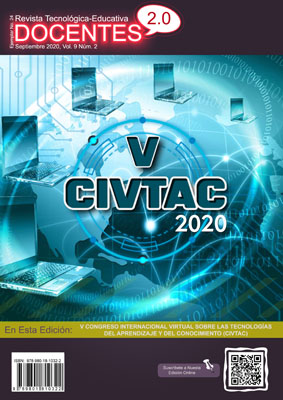The Influence of WhatsApp in Higher Education of the UNACAR
 DOI:
https://doi.org/10.37843/rted.v9i2.143
DOI:
https://doi.org/10.37843/rted.v9i2.143
Main Article Content
Abstract
Currently, the spread of cell phones, as well as applications for them, have been present in different sectors of society. Among the instant messaging applications, WhatsApp has stood out, which has become part of the daily life of most people who have a cell phone. The research focused on the use of WhatsApp, to know the influence it has among the students at the Autonomous University of Carmen (UNACAR). The objective of this research was to know, first how much they use WhatsApp, and second how much it is useful for their academic activities. A quantitative research was carried out, on an innovative topic that is present in everyday life, the WhatsApp, and its use among higher education students. For the study, a survey was applied to 100 students. The results obtained demonstrated the intensive use of said application. WhatsApp can become an effective communication tool between students and teachers, due to the scope of the use of the tool among people, most have a smartphone, which surely has the WhatsApp application installed, although there will be What to consider that there are other applications that possibly have better functionalities than WhatsApp. Based on the findings of the research carried out, it is concluded that WhatsApp is a widely used tool among higher level students.
Downloads
Metrics
Article Details

This work is licensed under a Creative Commons Attribution-NonCommercial-NoDerivatives 4.0 International License.
Those authors who have publications in our journal accept the following terms:
- When a work is accepted for publication, the author retains rights of reproduction, distribution of his/her article for exploitation in all countries of the world in the format provided by our magazine and any other magnetic medium, optical, and digital.
- Authors will retain their copyright and guarantee the journal the right first to publish their work, which will be simultaneously subject to the Creative Commons Acknowledgment License (Attribution-NonCommercial-NoDerivatives 4.0 International (CC BY-NC-ND 4.0)). That allows third parties to copy and redistribute the material in any medium or format, under the following conditions: Acknowledgment - You must properly acknowledge authorship, provide a link to the license, and indicate if any changes have been made. You may do so in any reasonable way, but not in a way that suggests you have the licensor's endorsement or receive it for your use. NonCommercial - You may not use the material for a commercial purpose. NoDerivatives - If you remix, transform, or build from the material, you cannot broadcast the modified material. There are no additional restrictions - You cannot apply legal terms or technological measures that legally restrict you from doing what the license allows.
- Authors may adopt other non-exclusive license agreements to distribute the published version of the work (e.g., deposit it in an institutional archive or publish it in a monographic volume) provided that the initial publication in this journal is indicated.
- Authors are allowed and recommended to disseminate their work through the Internet (e.g., in institutional telematic archives, repositories, libraries, or their website), producing exciting exchanges and increasing the published work's citations.
- Request of withdrawal an article has to be done in writing by the author to the Editor, becoming effective after a written response from the Editor. For this purpose, the author or authors will send correspondence via e-mail: [email protected].
- The author will not receive financial compensation for the publication of his work.
- All Docentes 2.0 Journal publications are under the Open Journal System (OJS) platform at: https://ojs.docentes20.com/.
References
ACDesDigital. (2019). ACDesDigital. Recuperado de: https://acdesdigital.org/whatsapp-web-caracteristicas-utilidades/
Arribas-Urritia, A., Islas-Carmona, O., & Gutiérrez-Cortés, F. (2019). De prosumidores a observadores: una tendencia emergente en Internet y en los jóvenes ecuatorianos. Resultados del estudio del World Internet Project, Ecuador. Revista Latina de Comunicación Social (72), 969-996. doi:10.4185/RLCS-2019-1367
Arribas-Urrutia, A. (2019). La brecha digital. Recuperado de: http://dspace.uhemisferios.edu.ec:8080/xmlui/handle/123456789/1069
Bedoya-Laguna, C. A. (2017). Diseño de un instrumento tipo escala Likert para la descripción de las actitudes hacia la tecnología por parte de los profesores de un colegio público de Bogotá. Bogotá, Colombia: Universidad Distrital Francisco José de Caldas. Recuperado de: http://repository.udistrital.edu.co/bitstream/11349/6881/1/BedoyaLagunaCrihstianAlberto2017.pdf
Bravo, M. (2020). Fayer Wayer. Recuperado de: https://www.fayerwayer.com/2020/03/whatsapp-web-trucos-internet/
Cahun, A. (2018). XATAKA Recuperado de: https://www.xataka.com.mx/aplicaciones/asi-nacio-whatsapp
Cascón-Baños, J. (2016). Frikipandi. Recuperado de: https://www.frikipandi.com/moviles/20160629/historia-whatsapp/
Castro, L. (2019). About español. Recuperado de: https://www.aboutespanol.com/que-es-im-o-mensajeria-instantanea-y-como-funciona-157567
Choundhury, S. (2019). Grabon. Recuperado de: https://blog.grabon.in/advantage-disadvantage-whatsapp/
Collado, C. (2020). Andro4all. Recuperado de: https://andro4all.com/guias/whatsapp/whatsapp-web-pc-tablet-movil
Real Academia Española (2014). Comunicación. La 23.ª edición. Recuperado de: https://dle.rae.es/comunicaci%C3%B3n
Hernández-Sampieri, R., Fernández-Collado, C., & Baptista-Lucio, M. (2104). Metodología de la investigación. McGraw-hill
Jiménez-Pitre, I. A., Jiménez-Pitre, N. L., & Molina-Bolivar, G. (2019). Proceso de aprendizaje en niños y adolescentes potencializado a través de las redes sociales. Revista Tecnológica-Educativa Docente 2.0, 7(2), 168-181. Recuperado de https://ojs.docentes20.com/index.php/revista-docentes20/article/view/78
López-Jiménez, D. F. (2007). La naturaleza de las tecnologías de información y comunicación: las TIC como determinantes de las organizaciones y de la sociedad de la información. Palabra Clave, 10(1), 72-93. Recuperado de: http://dspace.uhemisferios.edu.ec:8080/xmlui/handle/123456789/453
Matas, A. (2018). Diseño del formato de escalas tipo Likert: un estado de la cuestión. Revista electrónica de investigación educativa, 20(1), 38-47. doi:10.24320/redie.2018.20.1.1347
Máxima-Uriarte, J. (2020). La historia de la comunicación humana. Recuperado de: https://www.caracteristicas.co/historia-de-la-comunicacion-humana/
Mendoza, I. (2013). Utel blog Universidad. Recuperado de: https://www.utel.edu.mx/blog/10-consejos-para/historia-de-los-medios-de-comunicacion/
Michán, M. (2015). APPLESFERA. Recuperado de: https://www.applesfera.com/aplicaciones-ios-1/whatsapp-web-que-es-como-funciona-y-como-sacarle-el-mejor-partido
ONNE CREW. (2019). ONNE. Recuperado de: http://blog.onne.world/pros-cons-of-using-whatsapp-for-your-school/
Pahwa, A. (2020). FEEDOUGH. Recuperado de: https://www.feedough.com/history-of-whatsapp/
Portilla, D. (10 de abril de 2020). Herramientas de una aplicación móvil de mensajería instantánea para el fortalecimiento del proceso enseñanza – aprendizaje del inglés. Revista Tecnológica-Educativa Docentes 2.0, 9(1), 116-123. doi: https://doi.org/10.37843/rted.v9i1.109
Romero, J. (2020). Trecebits. Recuperado de: https://www.trecebits.com/2020/02/15/cual-es-el-origen-de-whatsapp-por-que-se-llama-whatsapp/
Salinas, A. (2017). Mott marketing. Recuperado de: https://mott.marketing/informacion-sobre-que-es-quien-creo-y-como-funciona-la-aplicacion-whatsapp/
Shum-Xie, Y. (2020). Qué es, cómo se usa, dónde se utiliza. Recuperado de: https://yiminshum.com/escala-likert-investigacion/
TICbeat. (2016). TICbeat. Recuperado de: https://www.ticbeat.com/cyborgcultura/el-significado-de-los-logotipos-de-whatsapp-twitter-o-airbnb/2/






